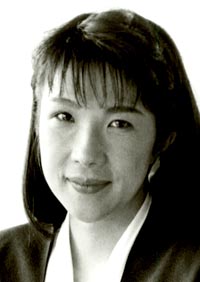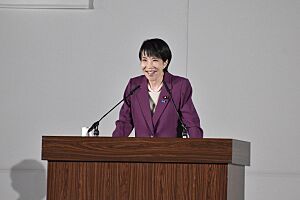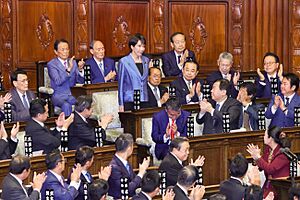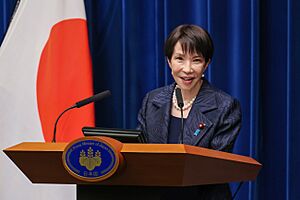Sanae Takaichi facts for kids
Quick facts for kids
Sanae Takaichi
|
|||||||||||||||||||||||||||||||||||||||||||||||||||||||||||||||||||||||||||||||||||
|---|---|---|---|---|---|---|---|---|---|---|---|---|---|---|---|---|---|---|---|---|---|---|---|---|---|---|---|---|---|---|---|---|---|---|---|---|---|---|---|---|---|---|---|---|---|---|---|---|---|---|---|---|---|---|---|---|---|---|---|---|---|---|---|---|---|---|---|---|---|---|---|---|---|---|---|---|---|---|---|---|---|---|---|
|
高市 早苗
|
|||||||||||||||||||||||||||||||||||||||||||||||||||||||||||||||||||||||||||||||||||
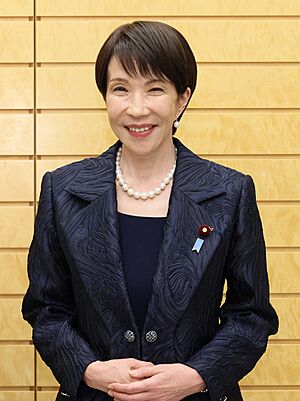
Takaichi in 2025
|
|||||||||||||||||||||||||||||||||||||||||||||||||||||||||||||||||||||||||||||||||||
| Prime Minister of Japan | |||||||||||||||||||||||||||||||||||||||||||||||||||||||||||||||||||||||||||||||||||
| Assumed office 21 October 2025 |
|||||||||||||||||||||||||||||||||||||||||||||||||||||||||||||||||||||||||||||||||||
| Monarch | Naruhito | ||||||||||||||||||||||||||||||||||||||||||||||||||||||||||||||||||||||||||||||||||
| Preceded by | Shigeru Ishiba | ||||||||||||||||||||||||||||||||||||||||||||||||||||||||||||||||||||||||||||||||||
| President of the Liberal Democratic Party | |||||||||||||||||||||||||||||||||||||||||||||||||||||||||||||||||||||||||||||||||||
| Assumed office 4 October 2025 |
|||||||||||||||||||||||||||||||||||||||||||||||||||||||||||||||||||||||||||||||||||
| Vice President | Tarō Asō | ||||||||||||||||||||||||||||||||||||||||||||||||||||||||||||||||||||||||||||||||||
| Secretary-General | Shun'ichi Suzuki | ||||||||||||||||||||||||||||||||||||||||||||||||||||||||||||||||||||||||||||||||||
| Preceded by | Shigeru Ishiba | ||||||||||||||||||||||||||||||||||||||||||||||||||||||||||||||||||||||||||||||||||
|
|||||||||||||||||||||||||||||||||||||||||||||||||||||||||||||||||||||||||||||||||||
| Member of the House of Representatives | |||||||||||||||||||||||||||||||||||||||||||||||||||||||||||||||||||||||||||||||||||
| Assumed office 11 September 2005 |
|||||||||||||||||||||||||||||||||||||||||||||||||||||||||||||||||||||||||||||||||||
| Preceded by | Tetsuji Nakamura | ||||||||||||||||||||||||||||||||||||||||||||||||||||||||||||||||||||||||||||||||||
| Constituency |
|
||||||||||||||||||||||||||||||||||||||||||||||||||||||||||||||||||||||||||||||||||
| Majority | 43,516 (20.38%) | ||||||||||||||||||||||||||||||||||||||||||||||||||||||||||||||||||||||||||||||||||
| In office 19 July 1993 – 8 November 2003 |
|||||||||||||||||||||||||||||||||||||||||||||||||||||||||||||||||||||||||||||||||||
| Constituency |
|
||||||||||||||||||||||||||||||||||||||||||||||||||||||||||||||||||||||||||||||||||
| Personal details | |||||||||||||||||||||||||||||||||||||||||||||||||||||||||||||||||||||||||||||||||||
| Born | 7 March 1961 Yamatokōriyama, Nara, Japan |
||||||||||||||||||||||||||||||||||||||||||||||||||||||||||||||||||||||||||||||||||
| Political party | Liberal Democratic (1996–present) | ||||||||||||||||||||||||||||||||||||||||||||||||||||||||||||||||||||||||||||||||||
| Other political affiliations |
|
||||||||||||||||||||||||||||||||||||||||||||||||||||||||||||||||||||||||||||||||||
| Spouses |
|
||||||||||||||||||||||||||||||||||||||||||||||||||||||||||||||||||||||||||||||||||
| Children | 3 | ||||||||||||||||||||||||||||||||||||||||||||||||||||||||||||||||||||||||||||||||||
| Education | Kobe University (BBA) | ||||||||||||||||||||||||||||||||||||||||||||||||||||||||||||||||||||||||||||||||||
| Signature | |||||||||||||||||||||||||||||||||||||||||||||||||||||||||||||||||||||||||||||||||||
| Japanese name | |||||||||||||||||||||||||||||||||||||||||||||||||||||||||||||||||||||||||||||||||||
| Revised Hepburn | Takaichi Sanae | ||||||||||||||||||||||||||||||||||||||||||||||||||||||||||||||||||||||||||||||||||
Sanae Takaichi (born 7 March 1961) is a Japanese politician who became the Prime Minister of Japan and President of the Liberal Democratic Party in 2025. She is the first woman to hold these important positions, and also the first person from Nara Prefecture to become Prime Minister. She has been a member of the House of Representatives since 2005, and also served in various government roles under former Prime Ministers Shinzo Abe and Fumio Kishida.
Takaichi grew up in Yamatokōriyama, Nara. She studied at Kobe University and worked as an author and broadcaster before starting her political career. She first joined the House of Representatives in 1993 as an independent politician. In 1996, she became a member of the Liberal Democratic Party (LDP). She held several important jobs during Shinzo Abe's time as Prime Minister, including Minister for Internal Affairs and Communications.
She ran for the leadership of the LDP three times. In 2021, she placed third. In 2024, she came first in the first round but lost in a runoff. In 2025, she won the leadership election, becoming the party's first female president. After forming an agreement with the Japan Innovation Party, Takaichi was chosen as Prime Minister by the National Diet on 21 October 2025.
Takaichi holds traditional political views. She supports government spending to help the economy and wants to continue policies like "Abenomics." She has traditional views on social topics, such as not supporting same-sex marriage or allowing married couples to keep separate surnames. She also supports changing Article 9 of the Constitution of Japan to clearly mention Japan's military, and she believes in a strong relationship with Taiwan and the US–Japan alliance.
Contents
Early Life and Education
Takaichi was born on 7 March 1961, in Yamatokōriyama, Nara Prefecture, where she grew up. Her father worked for a car company, and her mother was a police officer. She went to Nara Prefectural Unebi High School.
Even though she could have gone to universities in Tokyo, her parents wanted her to stay closer to home. So, Takaichi traveled six hours each day to attend Kobe University. She paid for her studies by working part-time. During university, she played the drums in a band. She earned a degree in business administration in 1984.
After university, she studied at the Matsushita Institute of Government and Management. In 1987, she went to the United States to work for a congresswoman. When she returned to Japan in 1989, she wrote books about her experiences. She also worked as a TV presenter for TV Asahi and Fuji Television.
Political Career
Becoming a Politician
Takaichi first tried to become a politician in 1992, running for a seat in the House of Councillors. She ran as an independent candidate but did not win.
Early Years in Parliament (1993–2006)
In 1993, Takaichi was elected to the House of Representatives, which is the lower house of Japan's parliament. She ran as an independent. The next year, she joined a small party called "Liberals," which later merged into the New Frontier Party.
In 1996, Takaichi was re-elected. Soon after, she joined the Liberal Democratic Party (LDP). She served in various roles, including as a junior minister for the Ministry of International Trade and Industry. She also chaired the Education and Science Committee.
In 2002, she became a senior vice minister for the Ministry of Economy, Trade and Industry. In 2003, she lost her seat in the Nara 1st district. She then moved and won a seat representing the Nara 2nd district in 2005. While out of parliament, she taught economics at Kinki University.
Takaichi was part of a group within the LDP that did not support a law allowing married couples to keep separate surnames. She believed this would change Japan's traditional family system.
Serving in Abe's Governments (2006–2007, 2012–2020)
Takaichi held several important roles in the government of Prime Minister Shinzō Abe. These included Minister of State for Okinawa and Northern Territories Affairs, and Minister of State for Science and Technology Policy. She also served as Minister of State for Youth Affairs and Gender Equality, and Minister of State for Food Safety.
In 2012, after the LDP won the election, Takaichi was chosen to lead the party's Policy Research Council. She later became Minister of Internal Affairs and Communications in September 2014.
In December 2014, she won her district election with a large number of votes. In 2017, she was replaced by Seiko Noda but returned to the Internal Affairs and Communications role in September 2019. During this time, she worked on issues like reducing NHK's TV license fee and helping to distribute cash payments during the COVID-19 pandemic.
Kishida Government (2022–2024)
From August 2022, Takaichi served as Minister of State for Economic Security in Prime Minister Fumio Kishida's government. Her job was to help create a system for handling secret information related to economic security. This system was important for Japan to work more closely with other countries on security matters. The new law was passed in May 2024.
In August 2023, Takaichi shared her concerns about selling the government's share in Nippon Telegraph and Telephone. She worried this could make Japan's communication systems vulnerable.
Becoming LDP President and Prime Minister (2021, 2024, 2025)
Takaichi ran for the leadership of the LDP three times. In August 2021, she announced her first attempt to become the party leader. She placed third in that election.
In August 2024, Prime Minister Fumio Kishida decided not to run for re-election as LDP President. Takaichi announced her second bid for the leadership. She was a leading candidate and won the first round of voting. However, she narrowly lost in the final runoff election to Shigeru Ishiba.
After Prime Minister Shigeru Ishiba announced his resignation in September 2025, Takaichi ran for LDP president for the third time. She won both rounds of voting, defeating Shinjirō Koizumi. This made her the first woman to become the president of the LDP.
LDP Presidency and Becoming Prime Minister
After Takaichi was elected as LDP president, people expected changes in Japan's economy. The Nikkei 225 stock market index reached a new high, and the value of the Japanese yen changed.
On 10 October, the Komeito party announced it would leave the governing coalition with the LDP. This ended a 26-year partnership. As a result, the vote in parliament to choose Japan's next prime minister was moved to 20 October. Takaichi then asked Hirofumi Yoshimura, the leader of the Japan Innovation Party, to form a new coalition with the LDP. They agreed on 19 October.
On 21 October 2025, both houses of the National Diet officially nominated Takaichi to become Prime Minister. She was then officially appointed by Emperor Naruhito in a ceremony at the Tokyo Imperial Palace. She made history as Japan's first female prime minister.
Premiership (2025–present)
After becoming Prime Minister on 21 October, Takaichi formed her government, known as the Takaichi Cabinet. She had hoped to include many women in her cabinet, similar to countries in Northern Europe. In the end, two women joined her cabinet: Satsuki Katayama became Japan's first female finance minister, and Kimi Onoda became the economic security minister. Takaichi explained that she chose ministers based on their skills and experience, focusing on "equality of opportunity."
Her cabinet included rivals from the LDP leadership race in key positions, showing a focus on party unity. For example, Toshimitsu Motegi became foreign minister, and Shinjiro Koizumi became defense minister.
In her first press conference as Prime Minister on 21 October 2025, Takaichi talked about her main goals. These included dealing with rising prices and suggesting a temporary halt to the gasoline tax. She also mentioned plans to create a backup capital city, improve the country's social security system, and change the constitution. She aims to create a stable government while listening to other political parties.
Takaichi also emphasized crisis management. She plans to increase cooperation between public and private sectors to invest in economic, energy, and food security. She is working on an economic plan worth about ¥13.9 trillion (around $92.19 billion). This plan focuses on fighting inflation, investing in growing industries, and national security. It also includes expanding grants for small businesses and investing more in technology like artificial intelligence and semiconductors.
On 24 October 2025, Takaichi announced that Japan would increase its annual military spending to 2% of its national income by March 2026, which is earlier than previously planned.
Political Views
Takaichi is known for her traditional political views. She looks up to former British prime minister Margaret Thatcher and is sometimes called the "Iron Lady." She is a member of Nippon Kaigi, an organization that promotes certain views on Japanese history.
Economic Policies
Takaichi believes in active government spending to support the economy. She supports investing heavily in important areas like artificial intelligence, semiconductors, nuclear fusion, biotechnology, and defense. She wants to continue economic policies similar to those of former Prime Minister Shinzo Abe, often called "Abenomics." She has suggested paying for economic plans by issuing government bonds.
In 2021, she proposed a "Plan to Strengthen the Japanese Economy," sometimes called "New Abenomics" or "Sanaenomics." This plan includes expanding money supply, flexible government spending during crises, and bold investments in crisis management and growth. She has also suggested increasing taxes on large companies.
Social Issues
Takaichi holds traditional views on several social topics. She has said that allowing married couples to have separate family names could weaken the traditional family structure. She also does not support changing the rules to allow women to become the Empress. While she does not support legalizing same-sex marriage, she believes there should be no unfair treatment based on a person's sexual orientation or gender identity. She supports promoting understanding of these issues.
Foreign Policy
Takaichi supports changing Article 9 of the Constitution of Japan to clearly mention Japan's military, known as the Japan Self-Defence Forces. She also wants to increase spending on defense to buy advanced equipment and support research. She believes it's important to be able to defend against threats. She supports laws to prevent spying and wants to create a national intelligence agency.
She has expressed concerns about some of China's economic practices, like stealing ideas and designs. She wants Japan to rely less on China economically. She supports a strong relationship with Taiwan and has said that a problem for Taiwan is a problem for Japan. In April 2025, she visited Taiwan and met with its president. She also supports strengthening the alliance between the US and Japan.
Regarding nuclear weapons, she has discussed the idea of allowing US nuclear weapons to be present in Japan during emergencies, to help with defense. She has also highlighted that conflicts like the war in Ukraine are important for Japan, especially considering Russian military bases near Japan and China's growing influence.
Personal Life
Takaichi married Taku Yamamoto, who was also a member of the House of Representatives, in 2004. They later divorced in 2017, but remarried in December 2021. Takaichi adopted Yamamoto's three children from a previous marriage, and she now has four grandchildren through them.
She is known to be friends with Yoshihiko Noda, the current leader of the CDP, even though they are in different political parties. Noda was her senior when they both studied at the Matsushita Institute of Government and Management.
Takaichi enjoys horse racing and listens to heavy metal music and Japanese rock. Some of her favorite artists are Demon Kakka, B'z, and X Japan. She also supports sports teams like Gamba Osaka and Hanshin Tigers. In her youth, Takaichi played the drums and piano. She is also a certified sommelier (wine expert) and enjoys motorcycles, having owned a Kawasaki Z400. Takaichi practices judo and karate, and is a scuba diver. She is also a car enthusiast, having owned a 1991 Toyota Supra A70 2.5GT Twin-Turbo Limited for over 20 years, which is now displayed in a museum. She is also a fan of manga, especially Bari Bari Densetsu.
See also
 In Spanish: Sanae Takaichi para niños
In Spanish: Sanae Takaichi para niños


